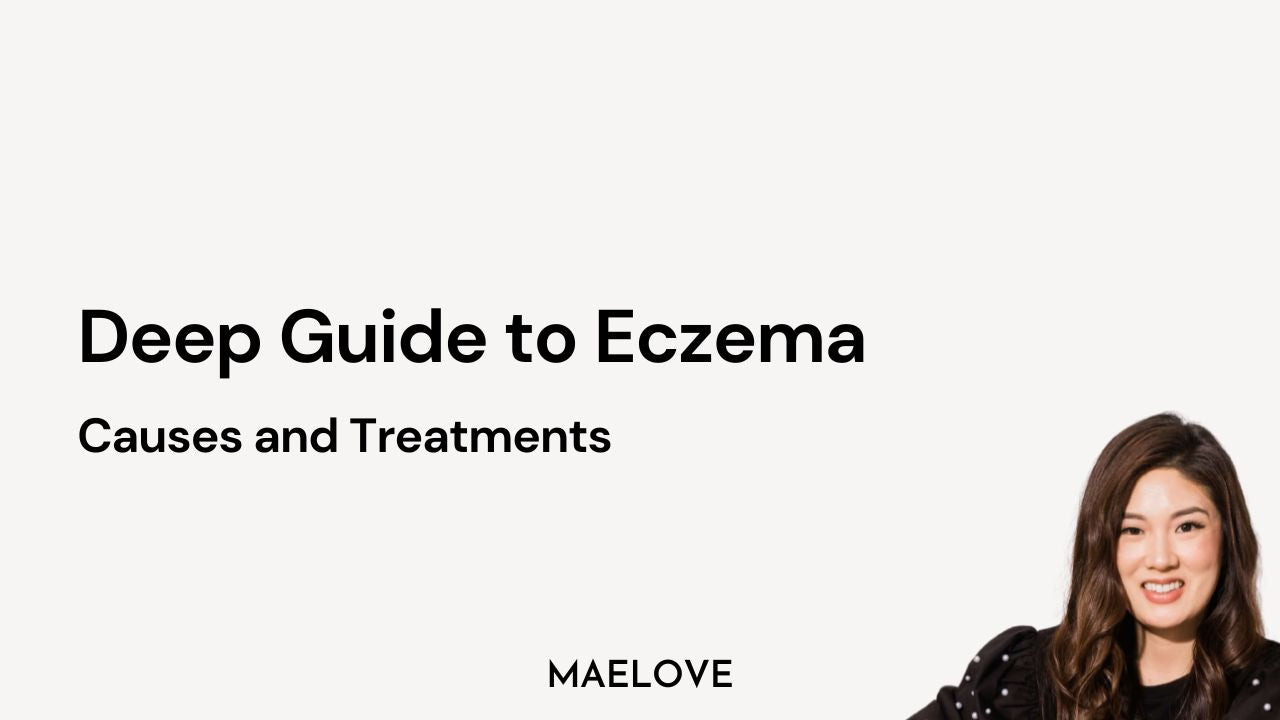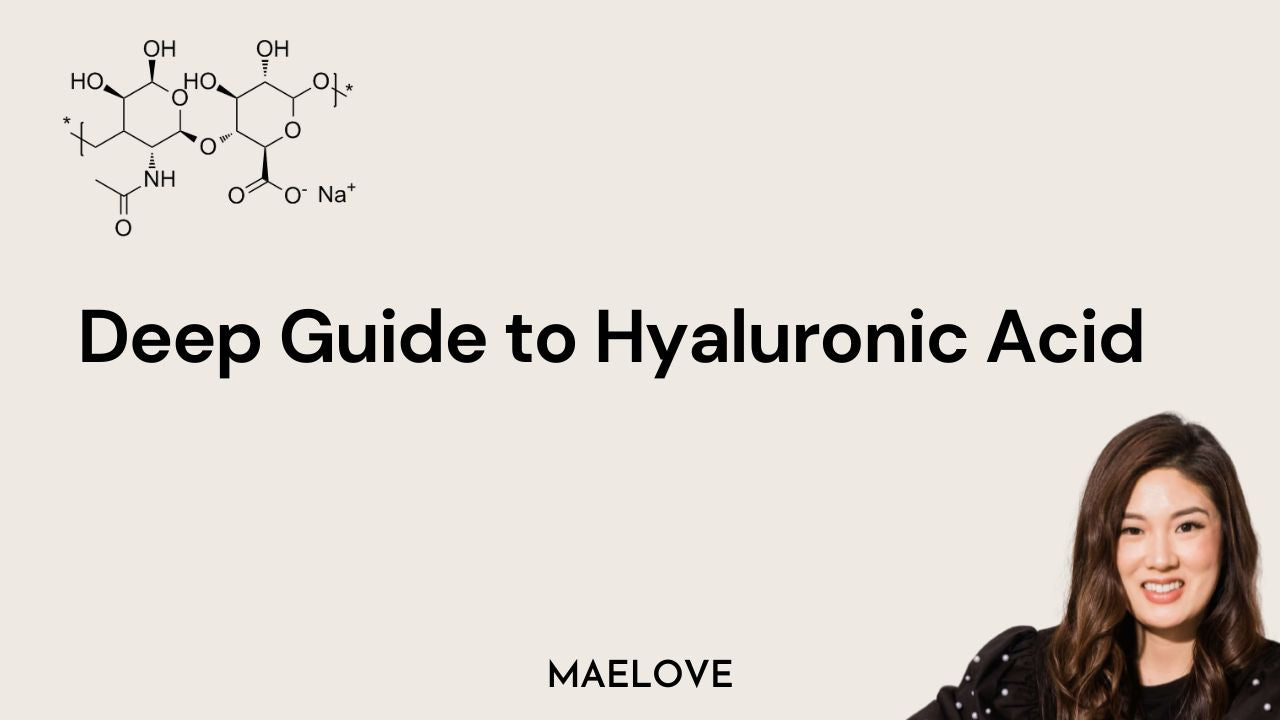Welcome to our deep guide on the topic of eczema. If you would like a shorter introduction into this topic, please check out our concise guide to eczema.
Eczema is an inflammatory skin condition particularly common in infants and children. However, many continue to suffer from eczema into adulthood leading to a lifelong struggle with dry, scaly, itchy, reddened patches of skin.
Those who have it may have a family history of developing allergic diseases or have a genetic mutation for a skin barrier defect.
To manage it, it is important to choose the right cleansers and to wash with cleansers daily. Further, application of moisturizers to the skin after cleansing is important and ample usage of moisturizers as needed or twice to three times daily is generally recommended.
In general, thicker balms, ointments and creams are preferable to thinner lotions and creams.
Cleansers that are mild, soap-free, sulfate-free, dye-free, fragrance-free cleansing with an acidic pH are recommended for those with eczema (AAD, Paller et al. 2023).
While thick, hydrating creams, balms, and ointments are recommended, many find balms and ointments heavy, greasy and unpleasant.
Proper cleansing and moisturization are key to managing adult eczema. When flare-ups do occur a wide variety of prescription options such as corticosteroids may be prescribed.
What is eczema and why do you get it?
Eczema is a skin condition that can make you feel itchy and cause dry, scaly, reddened patches of skin that can ooze, crust, crack, bleed and stick around for a while. It’s often called the “itch that rashes” because scratching can make it worse, creating a cycle that’s tough to break.
Eczema can really impact your life, especially if it affects your sleep. Sometimes, eczema gets better and sometimes it gets worse. When it gets worse, it’s called a flare-up (Harvard Health, Nutten 2015).
There are a few different types of eczema, with atopic eczema also known as atopic dermatitis (AD) being the most common (National Eczema Association). When people talk about eczema, they are generally referring to AD.
There’s also contact dermatitis, which happens when you come into contact with something that causes an allergic reaction, like poison ivy or poison oak. This type of eczema generally goes away when you find out what caused the allergy and remove it (AAD).
Eczema is often associated with babies and childhood as it is very common in these populations in whom the skin barrier and immune system are still developing. Most children outgrow eczema by the time they reach adolescence as the skin barrier and immune system mature (AAD). One estimate points to 70% of children outgrowing it by adolescence (Frazier and Bhardwaj 2020).
Though less common in adults, it is still fairly common in the adult population. Worldwide prevalence of atopic dermatitis by the International Study of Asthma and Allergies in Childhood is estimated to be 15-20% in children and 1-3% in adults (Odhiambo et al. 2009, Nutten 2015).
Factors such as race and geographic location affect these population statistics and can lead to variance of estimates across studies. Further, for reasons unknown, it’s becoming more prevalent worldwide particularly in children (Lee et al. 2016).
Adult eczema can also often look different from eczema in babies and children. Babies tend to get it on their face, scalp, trunk, and limbs, while older kids might get it in the creases of their skin like in the elbow crease.
Adults might have dry patches on their hands or just one area of their body. Adults with eczema are also susceptible to contact irritation for example in the lip region with saliva contact (Harvard Health, Frazier and Bhardwaj 2020, Paller et al 2023).
Unfortunately, having eczema can also increase your chances of developing other allergies, like food allergies or asthma and hay fever. Called the atopic march, about 50% of those with atopic dermatitis develop other allergies in their first year of life.
This may be in part due to the fact that those with eczema may be more genetically prone to developing allergies and in part due to the fact that chronically inflamed skin leads to sensitization to allergens.
Some people who get eczema have a family history of having an exaggerated immune response (Frazier and Bhardwaj 2020).
Others with eczema carry a gene for a skin barrier defect. About 50% of those with eczema have a mutation in a gene that codes for a protein called filaggrin which is integral for developing and maintaining a healthy skin barrier (Nutten 2015).
Filaggrin binds to keratin fibers and is necessary for the proper formation of corneocytes (skin cells) that form the outer surface of the skin (the stratum corneum).
Filaggrin is also important for stratum corneum hydration as it is the source of many natural moisturizing factors. People with a filaggrin mutation have a defective outer skin barrier that allows allergens, irritants, and bacteria to leak through. This leads to an immune response and chronic inflammation.
In other words, you may get eczema if you have a genetic tendency to get allergies or a skin barrier defect that allows allergens to get through your skin. The state of chronic skin inflammation further weakens the skin barrier contributing to the cycle of continued inflammation (Frazier and Bhardwaj 2020).
The good news is that there are ways to manage eczema, even if there’s no cure. If you have eczema, you can work with your doctor to find ways to prevent flare-ups and treat them when they happen. While it can be a complex condition with many different causes, there are options to help you feel better (AAD).
How do you manage eczema?
If you’re dealing with eczema, you may have heard that cutting back on washing and bathing can reduce flare-ups. This is a myth! In fact, you should do the exact opposite and bathe more (AAD).
This myth may be due to the fact that a harsh alkaline cleanser like soap will worsen eczema. Soaps and harsh detergents like sulfates can further disrupt your skin barrier. In other words, it is not cleansing that worsens eczema but the use of the wrong cleanser.
You want to use a cleanser that is soap-free, sulfate-free, dye-free, fragrance-free and has an acidic pH (AAD, Nutten 2015, Paller et al. 2023). Also, it is important to ALWAYS moisturize after cleansing to make sure skin stays hydrated.
Dermatologists recommend you take a bath or shower once daily with the right cleanser. Further, you want to apply a moisturizer with emollients after washing. You also want to moisturize as needed or twice to three times daily to manage your eczema. At least one study shows frequent bathing (in this case twice daily) with moisturization (“soak and seal”) helped control eczema compared to less frequent bathing (in this case, twice weekly).
The exception is in infants where less frequent bathing between two to four times a week rather than daily may be advised (Paller et al. 2023). Wet wrap therapy may also be advised after bathing to keep skin hydrated (Ring et al. 2012, Frazier and Bhardwaj 2020).
Washing with a cleanser is crucial as 90% of people with eczema have skin that is colonized with greater levels of harmful bacteria such as S. aureus. This is in part because those with eczema have an elevated skin pH that benefits the growth of S. aureus.
Since those with eczema have a disrupted skin barrier, the skin is also more susceptible to infection. To help remove scales, crusts, bacteria, allergens, and irritants from your skin surface, it’s important to take regular baths or showers with cleansers followed by immediate moisturization. Lukewarm water and a time limit is recommended although different doctors have different opinions (Paller et al. 2023).
In some cases, your doctor may even recommend twice weekly bathing with dilute bleach (½ cup of 6% bleach in 40 gallons of water) (Ring et al. 2012, Frazier and Bhardwaj 2020). This is because when dilute, bleach forms hypochlorous acid which can effectively kill microbes such as S. Aureus on the skin.
This effective killing action is due to pro-oxidant effects which are harmful to microbes but can also be harmful to skin. While generally regarded as safe, it is important to make sure to properly dilute bleach, limit the number of bleach baths, and discontinue if skin irritation or allergic reaction occurs.
Bath additives such as oils or colloidal oatmeal are widely used but there is no high quality evidence that this does anything useful. In fact, one study showed no benefit to bath additives and can also increase the risk of slipping in the bath and hence, are not recommended by the AAD and most doctors (AAD, Paller et al. 2023).
Afterwards, it is recommended to pat skin dry and then apply the moisturizer within three minutes of bathing to help seal in the moisture (AAD, Frazier and Bhardwaj 2020). Note that excessive bathing WITHOUT subsequent moisturization will make eczema worse! So it’s important to make sure to moisturize after a bath (Paller et al. 2023).
In terms of a moisturizer, there are over the counter options or prescription options. Studies show that both are equally effective, so it’s really up to you (Frazier and Bhardwaj 2020). In general, thicker balms, ointments and creams are preferable to thinner lotions and creams (Paller et al. 2023). Just be sure to avoid moisturizers that contain allergens like peanuts, oats and fragrances as they can cause skin sensitization and allergy (Ring et al. 2012, Paller et al. 2023).
How do you treat eczema flare-ups?
If you’re struggling with eczema flare-ups, your doctor may recommend using topical corticosteroids as the first line of treatment. Corticosteroids help decrease the inflammation and itching. Corticosteroids are typically used for two weeks or less because of concerns about side effects such as skin thinning. There are seven different corticosteroids with varying levels of potency, and your doctor will choose the one that’s best suited for your particular case (See figure reproduced from Frazier and Bhardwaj 2020).

At the very lowest level is hydrocortisone cream which can commonly be found over the counter at concentrations up to 1%. Stronger corticosteroids are prescription only. If the corticosteroid treatment doesn’t work, your doctor may move on to second line treatments, such as topical calcineurin inhibitors like tacrolimus (Protopic) and pimecrolimus (Elidel).
These mediations help suppress the immune response and reduce inflammation and itching. Pimecrolimus is for mild to moderate cases, and tacrolimus is for moderate to severe cases. (Frazier and Bhardwaj 2020).
Another second line treatment is UV phototherapy which can help reduce inflammation. UV therapy can have some drawbacks however - the same drawbacks that you may have from UV skin tanning which includes premature skin aging and skin reddening (Frazier 2020).
There are also newer topical treatments available like Crisaborole (Eucrisa) and Ruxolitinib (Opzelura) that your doctor may prescribe. Coal tar may also be recommended. In some cases, AD can not be controlled with topicals or UV phototherapy. In these cases, systemic treatments delivered either orally or through injection, are prescribed.
These treatments can suppress the immune system to reduce inflammation and itching. These include Dupilumab (Dupixent), Abrocitinib (Cibinqo), Upadacitinib (Rinvoq), Tralokinumab-Idrm (Adbry), and other immunosuppressant medications (ADA, Schmitt et al. 2007). Your doctor will work with you to find the best treatment plan for your particular situation.
Other considerations
People with eczema have more sensitive skin than others. So you may want to avoid anything that irritates your skin including chemicals and wool or nylon clothing. Perfumes and perfumed fabric softeners can also cause irritation. Smooth clothing such as cotton may be preferable. You also want to break the itch-scratch cycle and behavioral feedback may be beneficial to those with habitual scratching (Lee et al. 2016).
Arid environments and dry winter time air may also exacerbate eczema. Use a humidifier indoors to help increase the water content of the air in these instances. Emotional stress is also an exacerbating factor so it’s important to manage stress and anxiety (Paller et al. 2023).
Further, there is evidence that air pollutants such as tobacco smoke and traffic exhaust, mold exposure in damp environments and airborne allergens from house dust mites have a negative effect on eczema in children. Dust-mite free environments such as in the alpine climate, has been shown to lead to a significant and long lasting improvement in eczema. So if possible, try to keep an allergen-free home environment. For example, by using air purifiers in the home (Ring et al. 2012).
For adults with eczema, we recommend our Sheer Silk facial cleanser which offers a gentle cleansing experience that will not harm the skin barrier nor leave it feeling stripped and dry. [Check out Sheer Silk Cleanser]
And as for a moisturizer, we recommend our dye-free, fragrance-free Hydro Relief facial cream. This non-greasy cream with a luscious texture nonetheless offers powerful hydration equal to heavier, greasier creams and additionally has anti-aging benefits. [Check out Hydro Relief Cream]
References
American Academy of Dermatology Association Site. Eczema Types: Atopic Dermatitis Overview.
https://www.aad.org/public/diseases/eczema/types/atopic-dermatitis. Accessed April 2023.
Frazier W, Bhardwaj N (2020). “Atopic Dermatitis: Diagnosis and Treatment.” American Family Physician 101(10): 590-598.
Lee JH, Son SW, Cho SH (2016). “A Comprehensive Review of the Treatment of Atopic Eczema.” AAIR 8(3): 181-190.
Nutten S (2015). “Atopic Dermatitis: Global Epidemiology and Risk Factors.” Ann Nutr Metab 66 (suppl 1): 8-16.
Harvard Health Publishing Site (2015). “Atopic dermatitis and eczema.” https://www.health.harvard.edu/skin-and-hair/atopic-dermatitis-and-eczema-overview. Accessed April 2023.
Idhiambo JA, Williams HC, Clayton TO, Robertson CF, Asher MI, ISAAC Phase Three Study Group (2009). “Global variations in prevalence of eczema symptoms in children from ISAAC Phase Three.” J Allergy Clin Immunol 124: 1251-1258.
National Eczema Association Site. Atopic dermatitis- https://nationaleczema.org/eczema/types-of-eczema/atopic-dermatitis/ (Accessed January 2024)
Paller AD, Butala S, Howe W (2023). Treatment of Atopic Dermatitis (Eczema). In: UpToDate, Corona R (Ed), UpToDate, Waltham, MA (Accessed on January 15, 2024).
Ring J, Alomar A, Bieber T, Deleuran M, Fink-Wagner A, Gelmetti C, Gieler U, Lipozencic J, Luger T, Oranje AP, Schafer T, Schwennesen T, Seidenari S, Simon D, Stander S, Stingl G, Szalai S, Szepietowski JC, Taieb A, Werfel T, Wollenberg A, Darsow U (2012). “Guidelines for treatment of atopic eczema (atopic dermatitis) Part 1” JEADV 26: 1045-1060.
Schmitt J, Schakel K, Schmitt N, Meurer M (2007). “Systemic Treatment of Severe Atopic Eczema: A Systematic Review.” Acta Derm Venereol. 87: 100-111.


